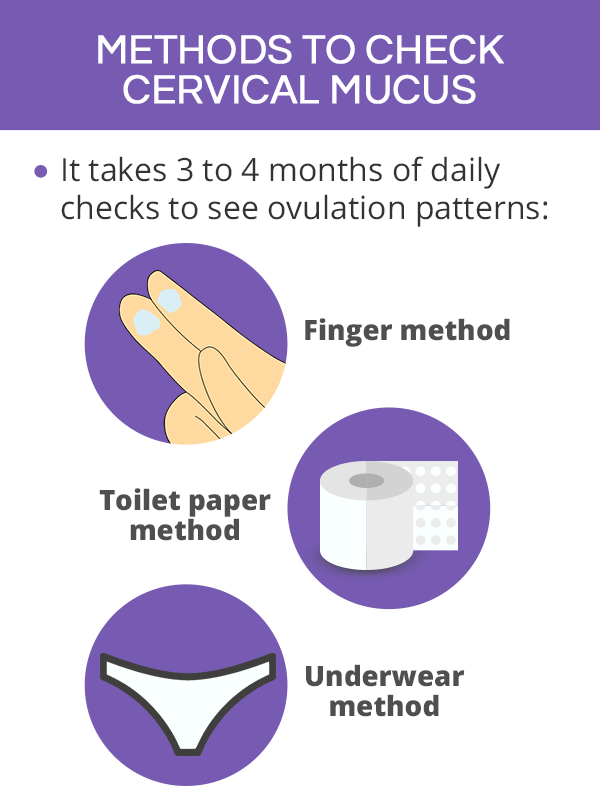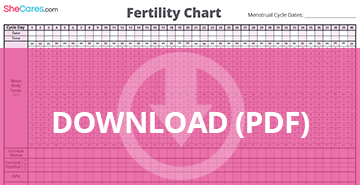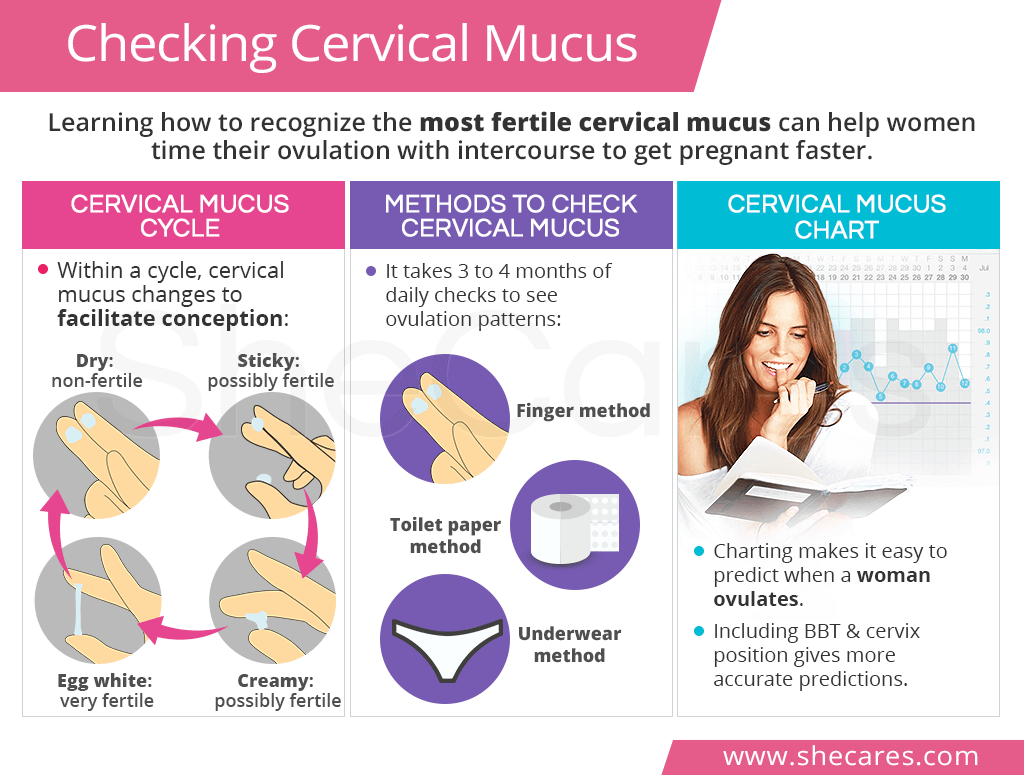What is Cervical Mucus?
Cervical mucus is a fluid that is produced in and secreted by the cervix due to fluctuations of estrogen and progesterone.
Because its main function is to facilitate conception on ovulation day, the consistency of cervical mucus changes throughout the cycle. Its texture and nutritional make-up determine whether sperm can survive in the reproductive tract.
Ovulation. Alkaline mucus around the time of ovulation makes the vagina less acidic, which enables the sperm to move to the fallopian tubes. It then nourishes the sperm in the reproductive tract for up to five days to make conception more feasible.
The rest of the cycle. When cervical mucus is not secreted, the pH in the vagina is low while the acidity is high. This makes the vaginal environment non-conductive to sperm. It is one of the body's mechanisms to prevent conception.
Cervical Mucus throughout Menstrual Cycle

In order to predict when ovulation occurs, it is beneficial to have a good understanding of the four general stages cervical discharge goes through within a menstrual cycle.
After a period and until ovulation, the mucus gradually transitions from being dry to being wet roughly in the following pattern:
Dry Stage (non-fertile): dry, damp, and barely noticeable (immediately following a period)
Sticky Stage (possibly fertile): sticky, white, clumpy, thick, and cloudy (approaching ovulation)
Creamy Stage (possibly fertile): creamy, thinner, and more abundant (approaching ovulation)
Wet Stage (very fertile): wet, slippery, clear, and stretchy, resembling egg whites (right before and during ovulation). It might be tinted pink or light brown if ovulation spotting is occurring.
This wet and slippery cervical mucus signals that a woman is in her most fertile days, and it is the best time to have sex. After ovulation and until the next period, the cervical fluid will transition back into the dry stage until the next cycle begins.
It is important to remember that not all women will experience all of the in-between stages clearly. They will, however, see the general transition from dryness to wetness.
Checking Cervical Mucus

Checking the cervical mucus is relatively easy, but it might take a while to make sense of all the changes at first.
The main idea is to pay attention to when the mucus becomes wet and slippery, which is the best hint that a woman's fertility window has opened and having sex is most likely to result in pregnancy.
When to Check Cervical Mucus
Unlike measuring basal body temperature, there is no specific time of the day to check the cervical mucus.
It can be done any time during the day while using the bathroom, but it should be checked daily for three to four cycles.1 It is best to start tracking the cervical fluid at the beginning of a new cycle in order to note all changes.
How to Check Cervical Mucus
There are three ways in which a woman can make observations about her cervical mucus:
Finger method is the best and easiest way to observe the consistency of the mucus. It is done by inserting a clean finger into the vagina close to the cervix, taking a sample of the fluid out, and examining it between the fingers. This method makes it very easy to check whether the mucus is thick or thin, sticky or slippery, etc.
Toilet paper method is another good way to observe the mucosal changes. It is done by wiping the vagina with a toilet paper and observing the residue. On its own, it does not allow for a full inspection of its texture. However, this method can be improved by simply touching the mucus on toilet paper and examining its consistency.
Underwear method is the least effective way to check the cervical mucus. In most cases, the discharge will have already dried out on the surface of the underwear or panty liner, which does not allow for a full examination of its consistency.
Keeping a Cervical Mucus Chart

Maintaining a cervical mucus chart is vital to predicting ovulation.
Most women do not chart their cervical mucus on its own, but rather chart it along with other ovulation signs and symptoms, such as measuring basal body temperature or checking cervical position, which produces the most accurate results.
A sample cervical mucus chart, which can be made by hand or downloaded, lists the days of the menstrual cycle on which a woman can mark her daily mucus observations. For clarity, the remarks can be noted with different colors corresponding to a given consistency or by convenient abbreviations, such as:

D for dry mucus
S for sticky mucus
C for creamy mucus
EW for egg whites mucus
The last day of wet and slippery mucus is considered the peak fertile day, which occurs right around the time when the egg is released from the ovary and can meet the sperm. It is usually marked as “PK” on the chart.
A woman should use one sheet per menstrual cycle to be able to understand her own ovulatory pattern and estimate ovulation more precisely. A number of ovulation predictors, such as ovulation trackers or monitors, enable women to input their observations and keep track of the changes in a convenient way.
Conclusions
Besides cervical mucus, a woman can also observe other common vaginal discharges, such as arousal fluid or seminal fluid, both of which are associated with sexual stimulation and intercourse, not a menstrual cycle. Vaginal discharge that is persistent, has an odor, distinct color, or comes with other symptoms, such as itchiness and burning, should be brought to a doctor's attention to rule out other causes. As such, it is especially important to be diligent about checking one's vaginal discharge and ensure that the observations a woman records are accurate.
This effective way of estimating ovulation is straightforward, easy, and does not require a purchase of any additional tools. Once a woman becomes comfortable in predicting when she ovulates, other ovulation tests, such as ovulation test kits or microscopes, can confirm that her predictions are valid and that she is, in fact, in her most fertile days.
Sources
- American Pregnancy Association. (2018). Cervical Mucus and Your Fertility. Retrieved September 4, 2018 from http://americanpregnancy.org/getting-pregnant/cervical-mucus/
- Fertility & Sterility. (2013). Cervical mucus monitoring prevalence and associated fecundability in women trying to conceive. Retrieved September 4, 2018 from https://www.ncbi.nlm.nih.gov/pmc/articles/PMC3787999/
- Office on Women's Healthy. (2018). Trying to conceive. Retrieved September 4, 2018 from https://www.womenshealth.gov/pregnancy/you-get-pregnant/trying-conceive
- University of North Carolina. (n.d.). Cervical Mucus Monitoring. Retrieved September 4, 2018 from https://www.med.unc.edu/timetoconceive/study-participant-resources/cervical-mucus-testing-information/


